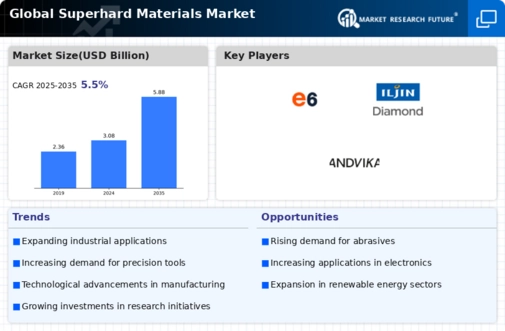-
Executive Summary
-
Market Introduction
-
Market Definition
-
Scope of the Study
-
List of Assumptions
-
Markets Structure
-
Market Research Methodology
-
Research
-
Process
-
Primary Research
-
Secondary Research
-
Market
-
Size Estimation
-
Forecast Model
-
Market Dynamics of Global Superhard
-
Materials Market
-
Introduction
-
Drivers
-
Restraints
-
Opportunities
-
Challenges
-
Trends/Technology
-
Market
-
Factor Analysis of Global Superhard Materials Market
-
Supply Chain Analysis
- Raw Material Suppliers
- Manufacturers/Producers
- End Users
-
Distributors/Retailers/Wholesalers/E-Commerce
-
Porter’s
- Threat of New Entrants
- Bargaining Power
- Bargaining Power of Suppliers
- Threat of Substitutes
- Intensity of Competitive Rivalry
-
Five Forces Analysis
-
of Buyers
-
Global Superhard Materials
-
Market, by Type
-
Introduction
-
Diamond
- Market Estimates
- Market Estimates & Forecast, by Region,
-
& Forecast, 2020−2027
-
Cubic Boron Nitride
- Market Estimates & Forecast,
- Market Estimates & Forecast, by Region, 2020−2027
-
Others
- Market Estimates & Forecast, 2020−2027
-
Market Estimates & Forecast, by Region, 2020−2027
-
Global Superhard
-
Materials Market, by Form
-
Introduction
-
Monocrystalline
- Market Estimates &
-
Market Estimates & Forecast, 2020−2027
-
Forecast, by Region, 2020−2027
-
Polycrystalline
- Market
- Market Estimates & Forecast,
-
Estimates & Forecast, 2020−2027
-
by Region, 2020−2027
-
Composite
- Market Estimates &
- Market Estimates & Forecast, by Region,
-
Forecast, 2020−2027
-
Global Superhard Materials Market, by End-Users
-
Introduction
-
Transportation
- Market Estimates & Forecast,
- Market Estimates & Forecast, by Region, 2020−2027
-
Building & Construction
- Market Estimates & Forecast, 2020−2027
- Market Estimates & Forecast, by Region, 2020−2027
-
Chemicals
- Market Estimates & Forecast, 2020−2027
- Market Estimates
-
& Forecast, by Region, 2020−2027
-
Oil & Gas
- Market
- Market Estimates & Forecast,
-
Estimates & Forecast, 2020−2027
-
by Region, 2020−2027
-
Mining
- Market Estimates & Forecast,
- Market Estimates & Forecast, by Region, 2020−2027
-
Electricals & Electronics
- Market Estimates & Forecast,
- Market Estimates & Forecast, by Region, 2020−2027
-
Others
- Market Estimates & Forecast, 2020−2027
-
Market Estimates & Forecast, by Region, 2020−2027
-
Global Superhard
-
Materials Market, by Region
-
Introduction
-
North America
- Market Estimates &
- Market Estimates & Forecast, by
- Market Estimates & Forecast, by End-Users,
- US
-
Market Estimates & Forecast, 2020−2027
-
Forecast, by Type, 2020−2027
-
Form, 2020−2027
-
Market Estimates & Forecast, by Form, 2020−2027
-
& Forecast, by End-Users, 2020−2027
-
Estimates & Forecast, 2020−2027
-
by Type, 2020−2027
-
Market Estimates
-
Canada
-
Market
-
Market Estimates & Forecast,
-
Market Estimates & Forecast, by Form,
-
Market Estimates & Forecast, by End-Users, 2020−2027
-
Europe
- Market Estimates & Forecast, 2020−2027
-
Market Estimates & Forecast, by Type, 2020−2027
-
& Forecast, by Form, 2020−2027
-
by End-Users, 2020−2027
-
Forecast, 2020−2027
-
France
-
Market Estimates
-
Market Estimates & Forecast,
-
Germany
-
Market Estimates &
-
Market Estimates & Forecast, by Type,
-
Market Estimates & Forecast, by Form, 2020−2027
-
Market Estimates & Forecast, by End-Users, 2020−2027
-
Market Estimates & Forecast, 2020−2027
-
Market Estimates & Forecast, by Type, 2020−2027
-
& Forecast, by Form, 2020−2027
-
by End-Users, 2020−2027
-
Forecast, 2020−2027
-
Spain
-
Market Estimates
-
Market Estimates & Forecast,
-
Italy
-
Market Estimates &
-
Market Estimates & Forecast, by Type,
-
Market Estimates & Forecast, by Form, 2020−2027
-
Market Estimates & Forecast, by End-Users, 2020−2027
-
Market Estimates & Forecast, 2020−2027
-
Market Estimates & Forecast, by Type, 2020−2027
-
& Forecast, by Form, 2020−2027
-
by End-Users, 2020−2027
-
Forecast, 2020−2027
-
Russia
-
Market Estimates
-
Market Estimates & Forecast,
-
UK
-
Market Estimates &
-
Market Estimates & Forecast, by Type,
-
Market Estimates & Forecast, by Form, 2020−2027
-
Market Estimates & Forecast, by End-Users, 2020−2027
-
Market Estimates & Forecast, 2020−2027
-
Market Estimates & Forecast, by Type, 2020−2027
-
& Forecast, by Form, 2020−2027
-
by End-Users, 2020−2027
-
& Forecast, 2020−2027
-
Type, 2020−2027
-
Rest of Europe
-
Market Estimates
-
Market Estimates & Forecast,
-
Poland
-
Market Estimates
-
Market Estimates & Forecast, by
-
Market Estimates & Forecast, by Form, 2020−2027
-
Market Estimates & Forecast, by End-Users, 2020−2027
-
Market Estimates & Forecast, 2020−2027
-
Market Estimates & Forecast, by Type, 2020−2027
-
Market Estimates & Forecast, by Form, 2020−2027
-
& Forecast, by End-Users, 2020−2027
-
Estimates & Forecast, 2020−2027
-
by Type, 2020−2027
-
China
-
Market Estimates
-
Asia-Pacific
- Market
- Market Estimates & Forecast,
- Market Estimates & Forecast, by Form, 2020−2027
- Market Estimates & Forecast, by End-Users, 2020−2027
-
Market Estimates & Forecast, by Type, 2020−2027
-
& Forecast, by Form, 2020−2027
-
by End-Users, 2020−2027
-
Forecast, 2020−2027
-
Japan
-
Market Estimates
-
Market Estimates & Forecast,
-
India
-
Market Estimates &
-
Market Estimates & Forecast, by Type,
-
Market Estimates & Forecast, by Form, 2020−2027
-
Market Estimates & Forecast, by End-Users, 2020−2027
-
Market Estimates & Forecast, 2020−2027
-
Market Estimates & Forecast, by Type, 2020−2027
-
& Forecast, by Form, 2020−2027
-
by End-Users, 2020−2027
-
Market Estimates & Forecast, 2020−2027
-
Forecast, by Type, 2020−2027
-
by Form, 2020−2027
-
Forecast, 2020−2027
-
Middle East & Africa
-
Estimates & Forecast, by Form, 2020−2027
-
Forecast, by End-Users, 2020−2027
-
& Forecast, 2020−2027
-
Type, 2020−2027
-
Israel
-
Market Estimates
-
Market Estimates & Forecast,
-
Australia & New Zealand
-
Market Estimates &
-
Market Estimates & Forecast,
-
Market Estimates & Forecast, by End-Users,
-
Rest of Asia-Pacific
-
Market Estimates &
-
Market Estimates & Forecast, by Type,
-
Market Estimates & Forecast, by Form, 2020−2027
-
Market Estimates & Forecast, by End-Users, 2020−2027
-
Market Estimates & Forecast, 2020−2027
-
Market Estimates & Forecast, by Type, 2020−2027
-
Market
-
Market Estimates &
-
GCC
-
Market Estimates
-
Market Estimates & Forecast, by
-
Market Estimates & Forecast, by Form, 2020−2027
-
Market Estimates & Forecast, by End-Users, 2020−2027
-
Market Estimates & Forecast, 2020−2027
-
Market Estimates & Forecast, by Type, 2020−2027
-
& Forecast, by Form, 2020−2027
-
by End-Users, 2020−2027
-
& Forecast, 2020−2027
-
Type, 2020−2027
-
Turkey
-
Market Estimates
-
Market Estimates & Forecast,
-
North Africa
-
Market Estimates
-
Market Estimates & Forecast, by
-
Market Estimates & Forecast, by Form, 2020−2027
-
Market Estimates & Forecast, by End-Users, 2020−2027
-
Market Estimates & Forecast, 2020−2027
-
Market Estimates & Forecast, by Type, 2020−2027
-
& Forecast, by Form, 2020−2027
-
by End-Users, 2020−2027
-
& Forecast, by Type, 2020−2027
-
by Form, 2020−2027
-
Estimates & Forecast, by End-Users, 2020−2027
-
Market Estimates & Forecast, 2020−2027
-
Forecast, by Type, 2020−2027
-
by Form, 2020−2027
-
Market Estimates
-
Market Estimates & Forecast,
-
Rest of the Middle East & Africa
-
Market Estimates & Forecast, 2020−2027
-
Market Estimates
-
Market Estimates & Forecast,
-
Market Estimates & Forecast, by End-Users,
-
Latin America
- Market Estimates & Forecast,
- Market Estimates & Forecast, by Type, 2020−2027
- Market Estimates & Forecast, by Form, 2020−2027
- Market
- Brazil
- Mexico
-
Market Estimates & Forecast, by End-Users, 2020−2027
-
Estimates & Forecast, by Type, 2020−2027
-
& Forecast, by Form, 2020−2027
-
by End-Users, 2020−2027
-
Estimates & Forecast, 2020−2027
-
by Type, 2020−2027
-
Argentina
-
Market Estimates & Forecast, 2020−2027
-
Market
-
Market Estimates
-
Market Estimates & Forecast,
-
Rest of Latin America
-
Market
-
Market Estimates & Forecast,
-
Market Estimates & Forecast, by Form,
-
Market Estimates & Forecast, by End-Users, 2020−2027
-
Company Landscape
-
Introduction
-
Market Strategy
-
Key Development Analysis
-
(Expansion/Merger & Acquisition/Joint Venture/New
-
Product Development/Agreement/Investment)
-
Company Profiles
-
Element Six
-
Products Offered
-
SWOT Analysis
-
Overview
-
Financial Overview
-
Key Developments
-
Ltd
-
Offered
-
Financial Overview
-
Key Developments
-
Ltd
-
Offered
-
Overview
-
Strategy
-
Yalong Superhard Materials Co. Ltd
-
Overview
-
Overview
-
Strategy
-
Hongjing New Materials Co. Ltd
-
Overview
-
Developments
-
Company Overview
-
Financial Overview
-
Strategy
-
Key Developments
-
Sandvik AB
- Company Overview
- Financial
- Products Offered
- Strategy
- Key Developments
- SWOT Analysis
-
Iljin Diamond
- Company Overview
- Products Offered
- Strategy
- SWOT Analysis
-
Henan Huanghe Whirlwind Co
- Company Overview
- Financial Overview
- Products
- Strategy
- Key Developments
- SWOT Analysis
-
Sumitomo Electric Industries Ltd
- Company Overview
- Products Offered
- Strategy
- SWOT Analysis
-
Funik Ultrahard Material Co.
- Company Overview
- Financial Overview
- Products
- Strategy
- Key Developments
- SWOT Analysis
-
SF Diamond Co Ltd
- Company Overview
- Financial Overview
- Products Offered
- Strategy
- Key Developments
- SWOT Analysis
-
WorldWide Superabrasives LLC
- Company
- Financial Overview
- Products Offered
- Key Developments
- SWOT Analysis
-
Henan
- Company Overview
- Financial
- Products Offered
- Strategy
- Key Developments
- SWOT Analysis
-
CR GEMS Superabrasives Co. Ltd
- Company
- Financial Overview
- Products Offered
- Key Developments
- SWOT Analysis
-
Anhui
- Company Overview
- Financial
- Products Offered
- Strategy
- Key
- SWOT Analysis
-
Conclusion
-
LIST OF TABLES
-
Global Superhard Materials Market, by Region, 2020−2027
-
North America: Superhard Materials Market, by Country, 2020−2027
-
Europe: Superhard Materials Market, by Country, 2020−2027
-
Asia-Pacific: Superhard Materials Market, by Country, 2020−2027
-
Middle East & Africa: Superhard Materials Market, by Country,
-
Latin America: Superhard Materials Market, by Country,
-
Global Superhard Materials Type Market, by Regions,
-
North America: Superhard Materials Type Market, by
-
Country, 2020−2027
-
Europe: Superhard Materials Type Market,
-
by Country, 2020−2027
-
Table10 Asia-Pacific: Superhard Materials Type
-
Market, by Country, 2020−2027
-
Table11 Middle East & Africa: Superhard
-
Materials Type Market, by Country, 2020−2027
-
Table12 Latin America:
-
Superhard Materials Type Market, by Country, 2020−2027
-
Table13 Global
-
Superhard Materials Form Market, by Regions, 2020−2027
-
Table14 North
-
America: Superhard Materials by Form Market, by Country, 2020−2027
-
Table15
-
Europe: Superhard Materials Form Market, by Country, 2020−2027
-
Table16
-
Asia-Pacific: Superhard Materials Form Market, by Country, 2020−2027
-
Table17
-
Middle East & Africa: Superhard Materials Form Market, by Country, 2020−2027
-
Table18 Latin America: Superhard Materials Form Market, by Country, 2020−2027
-
Table19 Global Superhard Materials End-Users Market, by Regions, 2020−2027
-
Table20 North America: Superhard Materials End-Users Market, by Country, 2020−2027
-
Table21 Europe: Superhard Materials End-Users Market, by Country, 2020−2027
-
Table22 Asia-Pacific: Superhard Materials End-Users Market, by Country, 2020−2027
-
Table23 Middle East & Africa: Superhard Materials End-Users Market, by
-
Country, 2020−2027
-
Table24 Latin America: Superhard Materials End-Users
-
Market, by Country, 2020−2027
-
Table25 Global Type Market, by Region,
-
Table26 Global Form Market, by Region, 2020−2027
-
Table27 Global End-Users Market, by Region, 2020−2027
-
Table28 North
-
America: Superhard Materials Market, by Country
-
Table29 North America: Superhard
-
Materials Market, by Type
-
Table30 North America: Superhard Materials Market,
-
by Form
-
Table31 North America: Superhard Materials Market, by End-Users
-
Table32 Europe: Superhard Materials Market, by Country
-
Table33 Europe: Superhard
-
Materials Market, by Type
-
Table34 Europe: Superhard Materials Market, by Form
-
Table35 Europe: Superhard Materials Market, by End-Users
-
Table36 Asia-Pacific:
-
Superhard Materials Market, by Country
-
Table37 Asia-Pacific: Superhard Materials
-
Market, by Type
-
Table38 Asia-Pacific: Superhard Materials Market, by Form
-
Table39 Asia-Pacific: Superhard Materials Market, by End-Users
-
Table40 Middle
-
East & Africa: Superhard Materials Market, by Country
-
Table41 Middle East
-
& Africa: Superhard Materials Market, by Type
-
Table42 Middle East &
-
Africa: Superhard Materials Market, by Form
-
Table43 Middle East & Africa:
-
Superhard Materials Market, by End-Users
-
Table44 Latin America: Superhard
-
Materials Market, by Country
-
Table45 Latin America: Superhard Materials Market,
-
by Type
-
Table46 Latin America: Superhard Materials Market, by Form
-
Table47
-
Latin America: Superhard Materials Market, by End-Users
-
LIST OF FIGURES
-
Global Superhard Materials Market Segmentation
-
Forecast
-
Research Methodology
-
Porters Five Forces Analysis of Global Superhard
-
Materials Market
-
Value Chain of Global Superhard Materials Market
-
Share of Global Superhard Materials Market in 2020, by Country (%)
-
Global Superhard Materials Market, 2020−2027
-
Global
-
Superhard Materials Market Size, by Type, 2020
-
Share of Global Superhard
-
Materials Market, by Type, 2020−2027
-
Global Superhard Materials
-
Market Size, by Form, 2020
-
Share of Global Superhard Materials Market,
-
by Form, 2020−2027
-
Global Superhard Materials Market Size,
-
by End-Users, 2020
-
Share of Global Superhard Materials Market, by
-
End-Users, 2020−2027

















Leave a Comment